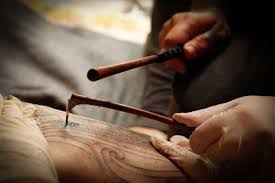

The principal traditional arts of the Maori may be broadly classified as carving in wood, stone, or bone, geometrical designs in plaiting and weaving, painted designs on wood and on the walls of rock shelters, and, finally, tattooing.
i) Carving
Carving was done in three media: wood, bone, and stone. Arguably ta moko was another form of carving. Wood carvings were used to decorate houses, fencepoles, containers, taiaha and other objects. The most popular type of stone used in carving was pounamu (greenstone), a form of jade, but other kinds were also used, especially in the North Island, where pounamu was not widely available. Both stone and bone were used to create jewellery such as the hei-tiki. Large scale stone face carvings were also sometimes created. The introduction of metal tools by Europeans allowed more intricacy and delicacy, and caused stone and bone fish hooks and other tools to become purely decorative. Carving is traditionally a tapu activity performed by men only.

ii) Ta Moko
Ta moko is the art of traditional Māori tattooing, done with a chisel. Men were tattooed on many parts of their bodies, including faces, buttocks and thighs. Women were usually tattooed only on the lips and chin. Moko conveyed a person's ancestry. The art declined in the 19th century following the introduction of Christianity, but in recent decades has undergone a revival. Although modern moko are in traditional styles, most are carried out using modern equipment. Body parts such as the arms, legs and back are popular locations for modern moko, although some are still on the face.

ta moko
iii) Weaving
Although the oldest forms of Māori art are rock paintings, in 'classical' Māori art, painting was not an important art form. It was mainly used as a minor decoration in meeting houses, in stylised forms such as the koru. Europeans introduced Māori to their more figurative style of art, and in the 19th century less stylised depictions of people and plants began to appear on the walls of meeting houses in place of traditional carvings and woven panels. The introduction of European paints also allowed traditional painting to flourish, as brighter and more distinct colours could be produced.

weaving